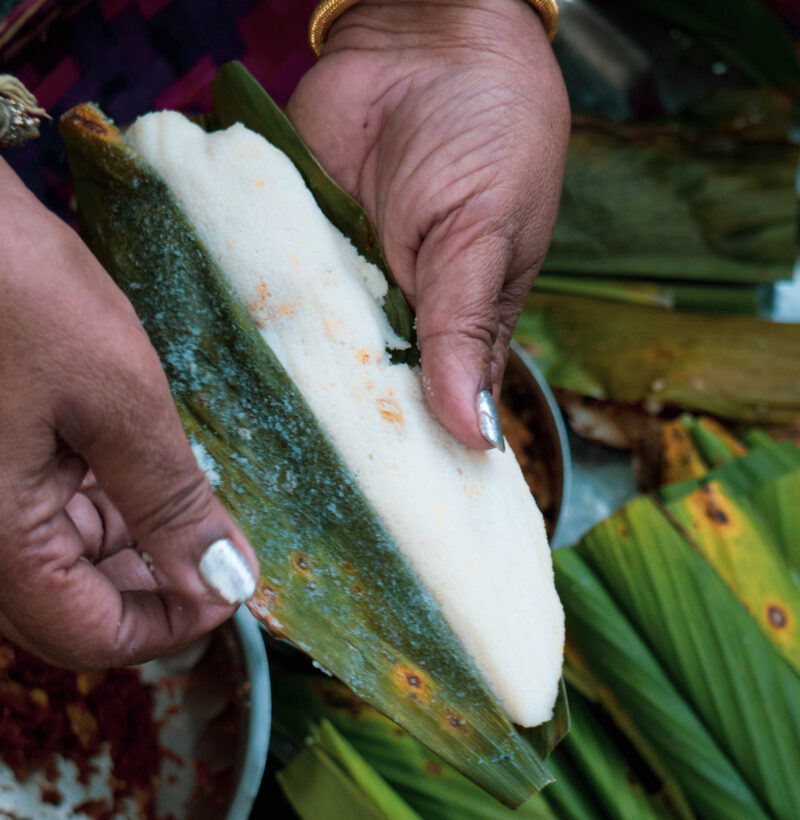
Pitha, which loosely translates to pancake or rice cake, covers an entire category of dishes including pancakes, dumplings or fritters in Odia cuisine. They can be sweet or savoury, and typically consist of a batter or dough which are sometimes stuffed and then steamed, baked, fried or cooked on a griddle.
Enduri pitha is a variety of pitha made using a fermented batter of ground rice and urad dal. Enveloped in fresh turmeric leaves, it has a stuffing of grated coconut, jaggery and spices. Traditionally, it is steamed in wide-mouthed earthen pots called athara handi. A frame made with twigs is placed inside the pot above the level of the water, and the pithas are placed on top of this frame to be steamed.
Prepared usually only once a year during Prathamastami, just before winter sets in, this is a ritual that celebrates the life and prosperity of first-borns in a family. This can be traced back to a time when infant mortality was high, and a child’s survival beyond the first few years was celebrated.
For the Wrapping
| Fresh turmeric leaves | 20 pcs |
|---|---|
| Salt | 1½ tsp |
| Polished white rice | 250gms | 11½ cup + 2 tbsp |
| Urad dal, white | 250gms | 11½ cup + 2 tbsp |
For the filling
| Nutmeg powder | ⅛ tsp |
|---|---|
| Clove powder | ⅛ tsp |
| Black pepper powder | ¼ tsp |
| Cardamom powder | ¼ tsp |
| Jaggery | 1 cup |
| Chenna or khoya | 1½ cup |
| Cashewnuts | 2 tablespoons |
| White raisins | 2 tablespoons |
| Grated coconut | 1 cup |
What You Will Need
Tools you will need include a mixer grinder, spatula, whisk, kadai, mortar and pestle, and a momo or idli steamer.
Wash the turmeric leaves, and pat them dry with a clean towel.
Wash and soak the dal and rice separately for 3 to 4 hours, and strain out the excess water.
Grind the dal to a smooth paste, and grind the rice to a coarse paste, each with just enough water to be able to grind them.
Whip the dal paste with salt using a whisk till it’s light and fluffy. Mix it well with rice paste and keep this mixture aside for 6 to 7 hours, or overnight at room temperature to allow it to ferment.

Squeeze the whey water from the chenna using a clean cloth, and keep aside.
Grind the spices using a mortar and pestle for a coarse texture.
Instructions
Heat the kadai over a medium flame. Once it is sufficiently hot, lightly fry the grated coconut with jaggery, cashew nuts and raisins for 3 to 4 minutes till it turns a golden brown colour.

Add the ground spices, mix it all properly, and empty the mixture into a bowl.
In the same kadai, cook the chenna (after removing the excess whey water) for a few minutes till it is almost crumbly, but has retained some moisture. Mix this with the coconut mixture, and keep this filling aside.
To assemble each pitha, take a turmeric leaf, place a little of the rice batter on the center of it, and spread it lengthwise to make an even layer, but not one that’s too thin. Add the stuffing on the center of the layer of batter, and fold the leaf sideways as it would close naturally.

Get the steamer ready with simmering hot water.
Arrange the prepared leaf parcels side by side without too much overlap.

Cover and steam for 20 to 25 minutes till the batter is firm to touch, and a toothpick inserted in its center comes out clean.

Let it cool slightly. Peel the leaf, and serve the pithas with potato curry or rice kheer.

Tips
Oversteaming the pitha will make it hard, so get the timing right by checking occasionally with a toothpick.
Make sure the rice and urad dal batters are ground separately to the correct consistencies as mentioned above.
Fermenting the batter for enough time is important to get a soft texture in the finished pithas.
Variations
The pithas can also be stuffed with a simple chenna and sugar mixture, or a savoury mixture of potato and spice powders. Sometimes, it is also steamed without any filling, and eaten as an accompaniment to Odia mutton curry.
Rachit Kirteeman is a consultant chef and visual storyteller by profession, and an avid traveller. A culture geek, he operates at the fascinating intersection of history, heritage and food. He loves collecting coffee, books, LPs and Hotwheels. When not cooking or helping people cook, he can be found travelling in search of delectable cuisines, related stories and cultures that drive those very dishes.
You must be logged in to rate this recipe.

Sign in with email


1 comment
This reminds me of the Kerala ada!